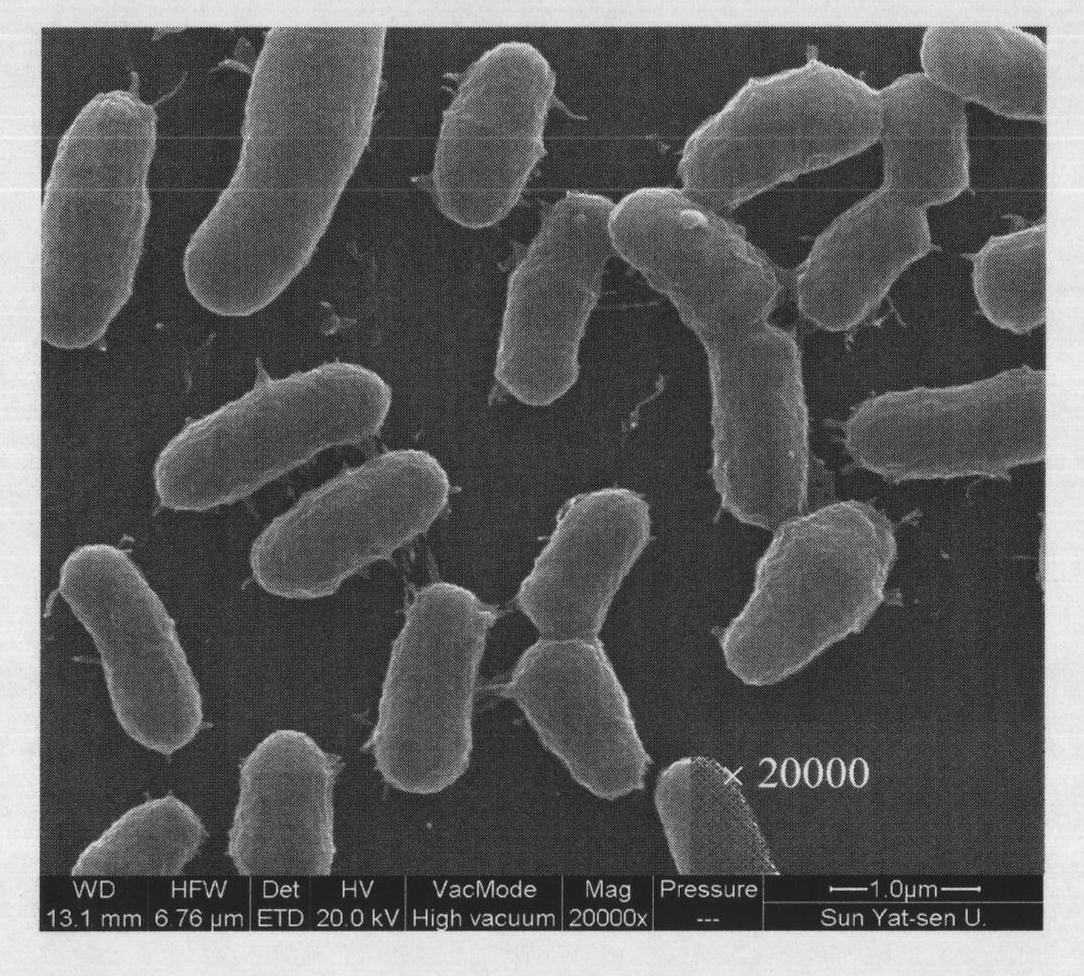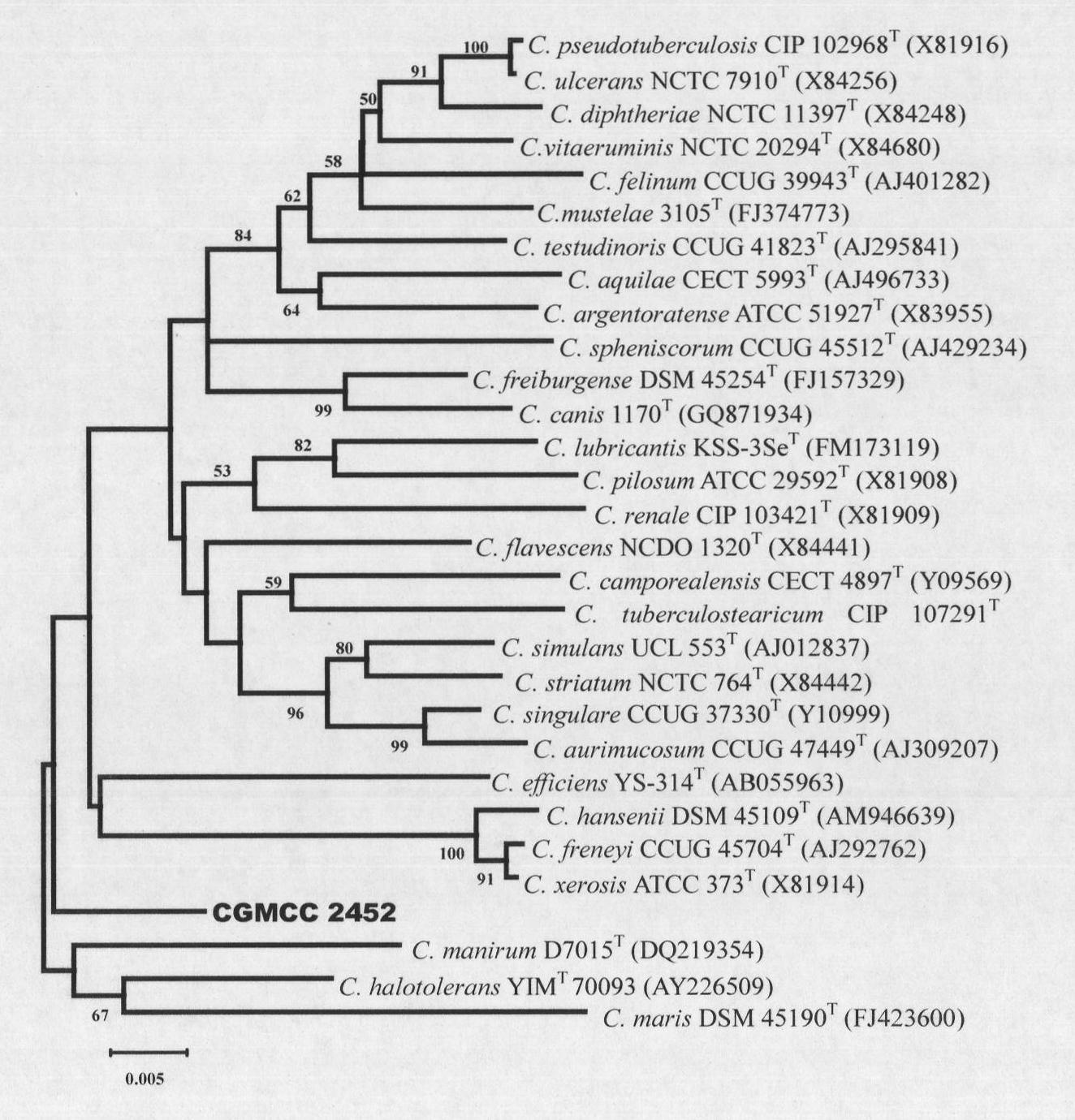Corynebacterium humireducens and application thereof
A corynebacterium and humus technology, applied in the direction of bacteria, biochemical fuel cells, microorganisms, etc., can solve the problems of unfavorable microbial growth, and no strains with humus reduction and electricity production activity have been found, and achieve high efficiency humus reduction ability and electricity production activity, Stable electricity production and broad application prospects
- Summary
- Abstract
- Description
- Claims
- Application Information
AI Technical Summary
Problems solved by technology
Method used
Image
Examples
Embodiment 1
[0034] Embodiment 1: Isolation and purification of humus-reducing Corynebacterium of the present invention
[0035] 1) Take 5mL anolyte from the sludge microbial fuel cell with pH 10 and inoculate it in 100mL liquid separation medium.
[0036] The structure of the sludge microbial fuel cell has been described in detail in the patent application No. 200910041235.4.
[0037] The composition of described liquid separation medium is: contain 1.0g glucose (electron donor), 16g AQDS (electron acceptor), 2.5g NaHCO in every liter of liquid separation medium 3 , 0.25gNH 4Cl, 0.678g NaH 2 PO 4 2H 2 O, 0.1g KCl, 10.0mL vitamin solution, 10.0mL trace element solution, the pH value is 10. Among them, the vitamin solution contains 2.0 mg biotin, 2.0 mg folic acid, and 10.0 mg vitamin B per liter of deionized water. 6 , 5.0mg thiamine, 5.0mg riboflavin, 5.0mg niacin, 5.0mg calcium pantothenate, 0.1mg vitamin B 12 , 5.0mg p-aminobenzoic acid, 5.0mg lipoic acid; the trace element solut...
Embodiment 2
[0042] Embodiment 2: Physiological and biochemical characteristics of bacterial strain (Corynebacterium humireducens)
[0043] The strain is a non-fermentative facultative anaerobic bacteria, resistant to salt and alkali. The growth temperature ranges from 25 to 40°C, and cannot grow above 45°C and below 10°C; the growth pH range is 7.0 to 11.0 (optimum: pH9.0); the NaCl% required for growth is 0 to 12% (> 13% cannot growth). According to the physiological and biochemical characteristics, the bacterium was identified as Corynebacteria.
[0044] Table 1 Physiological and biochemical characteristics of the inventive strain
[0045]
[0046]
[0047] + indicates a positive reaction; - indicates a negative reaction
Embodiment 3
[0048] Example 3: Molecular taxonomic status of strains (Corynebacterium humireducens)
[0049] as attached figure 2 As shown, the 6 strains with the closest homology of the invented strain all belong to Corynebacterium, which are respectively: C.marinum (similarity 96.9%, 1393bp), C.testudinoris (96.8%, 1395bp), C.halotolerans (96.4% , 1392bp), C.felinum (96.0%, 1383bp), C.singulare (96.0%, 1297bp) and C.freiburgense (95.9%, 1395bp). According to the phylogenetic theory, only when the similarity between the strains is greater than 97%, can they be considered as the same strain, and the similarity between the target strain and its closest strain C.marinum is only 96.9%, so the strain is defined as a new species.
[0050] Combining the above physiological and biochemical characteristics and the results of 16SrRNA sequence comparison, the Corynebacterium humireducens of the present invention belongs to the genus Corynebacterium, is a new species of this genus, and is named Cor...
PUM
 Login to View More
Login to View More Abstract
Description
Claims
Application Information
 Login to View More
Login to View More - R&D
- Intellectual Property
- Life Sciences
- Materials
- Tech Scout
- Unparalleled Data Quality
- Higher Quality Content
- 60% Fewer Hallucinations
Browse by: Latest US Patents, China's latest patents, Technical Efficacy Thesaurus, Application Domain, Technology Topic, Popular Technical Reports.
© 2025 PatSnap. All rights reserved.Legal|Privacy policy|Modern Slavery Act Transparency Statement|Sitemap|About US| Contact US: help@patsnap.com



